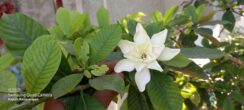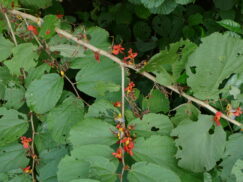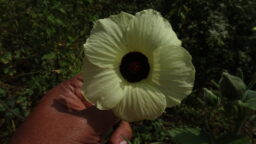
Common Name: Malabar nut. Tamil Name: Adhatoda Malabar nut is an evergreen shrub which grows to a height of about 2.5 meter. The leaf stalk and leaf length is around 3 cm and 22 cm respectively. The leaves are simple and oppositely arranged and are bunched at the end of the branches. The leaf shape is elliptic-lanceolate, as many as 15 pairs of secondary veins are seen on the lower side of the leaf surface. The leaf base is cuneate and tip is acute; leaf margin is entire. The inflorescence is in the form of an axillary spike. The flower is surrounded by 2 large green oval shaped bracts which are nearly 2.5 cm long; smaller bracteoles are also seen. The flowers are bi-lipped and white in color. The corolla throat has some reddish markings. The flower has 2 stamens held under the hood of the upper lip. The fruit is in the form of a capsule and contain round shaped seeds. Malabar nut is an important plant in traditional Indian medicinal systems and used in the treatment of coughs, cold and other respiratory diseases. The plant emits a strong odor; it is avoided by herbivores (hence the name Adhatoda in Tamil). The plant is cultivated as a hedge cum medicinal plant in villages and farmlands. I saw it used as hedge plant in an Irula village in Nilgiri district at 1000 msl. Malabar nut is a very sturdy plant and withstand hot climatic conditions. This plant is commonly deployed as a hedge plant in rural areas of Coimbatore district. The commercial cultivation of this plant for medicinal purposes has been successful and various inter-cropping techniques with other commercial plants have been worked out.





